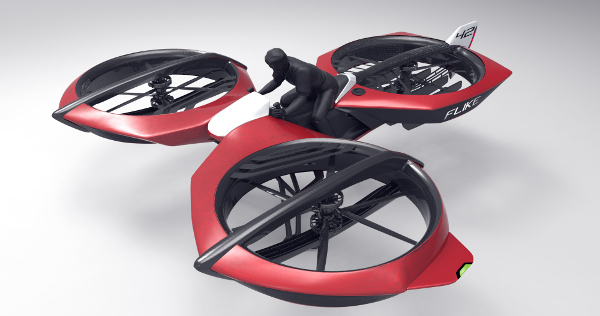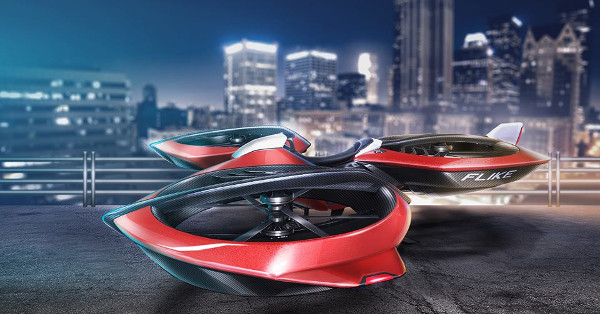Flike – The Flying Bike
How would you like one of these?

FLIKE CONCEPT MODEL
“There are size limitations for drone technology. Don't expect to have one that is heavy enough to carry a person”.
These words, written in an article in 2014, spurred Hungarian businessman and aircraft engineer, Balazs Kerulo, to design Flike – the first commercially available flying bike.
Kerulo set out to challenge the statement by looking at the mathematical issues of drone technology. Within just a couple of months, he'd managed to develop a working prototype. And after posting it on
YouTube, it went viral.

FIRST CONTROLLED FLIGHT
At the time, Kerulo worked at Bay Zoltán Nonprofit Ltd. - Hungary's largest and most successful institution for applied research. He managed to gain funding for his project and help from a team of engineers.
Flike is now being developed by the private company, ByeGravity, of which Kerulo is now CEO. The
latest concept video shows a modern looking design which the pilot is flying over the ocean.
Flike in flight
Flike is a flying 'tricopter', lifted by six rotors grouped in counter-rotating pairs of three axes, which are positioned around a circle and spin in unison. It's electric powered and emits zero emissions.
A control panel in front of the pilot will be used to control flight. The movement happens by changing the rotation speed of one of the rotors. In the event of a motor stopping working during flight, the other motors can power enough rotors for an emergency life, so the machine won't crash. Flike can also be manoeuvred by remote control in unmanned autonomous flight.

FIRST CONCEPT MODEL
It will be able to carry one person for about one hour and with speeds of up to 100kph. Due to electronic limitations, its maximum height will be 30 meters.
Flike will be available for the public to buy, but it's expected to cost about £85,000. Users will need to have a microlight pilot's licence in order to fly it.
The developers are also working on individualisation options for the machine. So buyers will be able to match their tastes to it and add a stamp of their own personality. Something we see an increasing number of manufacturers doing these days.
The Flike vision
Kerulo says of the project: 'I think personal flight has been the collective vision of mankind since the invention of science fiction. In science fiction movies since the 1940s, you can see people flying in their own private flying devices. Mankind is actually expecting something like this to happen.
'I think this technology will creep into cities in the next 20 or 30 years but I foresee that it will take another 40 to 50 years for it to become as common as cars are now.'

LATEST CONCEPT MODEL
As well as being a luxury hobbyist model, Kerulo sees a bigger future for Flike. One in which the machine is used for search and rescue missions, to deploy first aid staff to the scene of accidents.
Flike won Kerulo a place on last year’s New Europe 100 list of central and eastern Europe’s brightest and best people.
A similar project is also underway in the UK in the form of the
Hoverbike, a campaign which was launched in 2014. Development is still in progress.
Comments
20/12/16 - I would love one of these to give to my son who is mad on any form of copter
20/12/16 - Looks like a bikopter to me .
20/12/16 - Why would there be size limitations? That was a stupid thing to say!
23/12/16 - At a guess, 2014 battery technology. Things have moved on, in part at least because of electric vehicles.
23/12/16 - There are limitations on the length of efficient rotor blades due to the effect of supersonic speeds on blade tips but you would have to build a drone bigger than a full size helicopter before that became an issue.
21/12/16 - Surrounded by unshielded props.... no thanks haha.
21/12/16 - Found our next bikes





